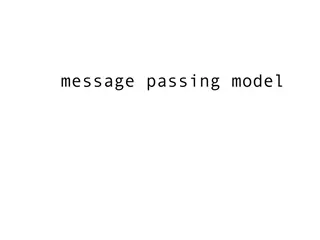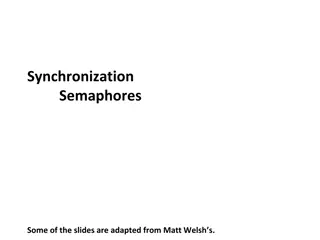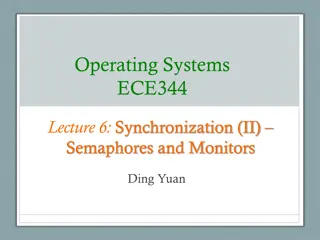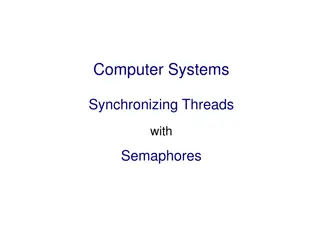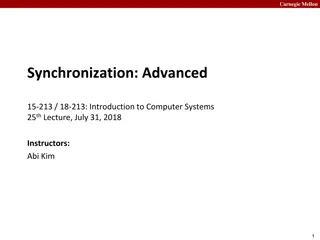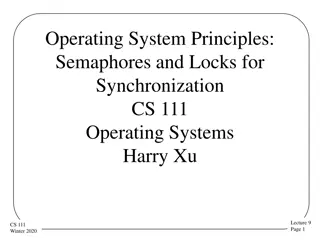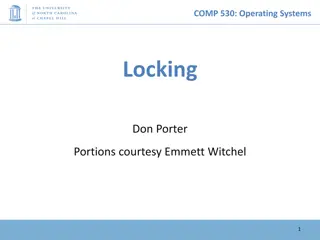CS 537 Concurrency and Semaphores Overview
This content covers essential topics in CS 537 - Introduction to Operating Systems, including concurrency, semaphores, condition variables, and join implementations. It delves into mutual exclusion, ordering, lock implementation, and more. The lecture provides insights into implementing join and producer/consumer scenarios while highlighting the differences between semaphores and condition variables.
Download Presentation

Please find below an Image/Link to download the presentation.
The content on the website is provided AS IS for your information and personal use only. It may not be sold, licensed, or shared on other websites without obtaining consent from the author.If you encounter any issues during the download, it is possible that the publisher has removed the file from their server.
You are allowed to download the files provided on this website for personal or commercial use, subject to the condition that they are used lawfully. All files are the property of their respective owners.
The content on the website is provided AS IS for your information and personal use only. It may not be sold, licensed, or shared on other websites without obtaining consent from the author.
E N D
Presentation Transcript
Announcements Project 2a: Graded see Learn@UW; contact your TA if questions Part 2b will be longer . Exam 2: Monday 10/26 7:15 9:15 Ingraham B10 Covers all of Concurrency Piece (lecture and book) Light on chapter 29, nothing from chapter 33 Very few questions from Virtualization Piece Multiple choice (fewer pure true/false) Look at two concurrency homeworks Questions from Project 2 Project 3: Only xv6 part; watch two videos early Due Wed 10/28 Today s Reading: Chapter 31
UNIVERSITY of WISCONSIN-MADISON Computer Sciences Department CS 537 Introduction to Operating Systems Andrea C. Arpaci-Dusseau Remzi H. Arpaci-Dusseau Semaphores Questions answered in this lecture: Review: How to implement join with condition variables? Review: How to implement producer/consumer with condition variables? What is the difference between semaphores and condition variables? How to implement a lock with semaphores? How to implement semaphores with locks and condition variables? How to implement join and producer/consumer with semaphores? How to implement reader/writer locks with semaphores?
Concurrency Objectives Mutual exclusion(e.g., A and B don t run at same time) - solved with locks Ordering (e.g., B runs after A does something) - solved with condition variables and semaphores
Condition Variables wait(cond_t *cv, mutex_t *lock) - assumes the lock is held when wait() is called - puts caller to sleep + releases the lock (atomically) - when awoken, reacquires lock before returning signal(cond_t *cv) - wake a single waiting thread (if >= 1 thread is waiting) - if there is no waiting thread, just return, doing nothing
Join Implementation: COrrect Parent: Child: void thread_exit() { Mutex_lock(&m); done = 1; Cond_signal(&c); Mutex_unlock(&m); } void thread_join() { Mutex_lock(&m); if (done == 0) Cond_wait(&c, &m); // y Mutex_unlock(&m); } // a // b // c // d // w // x // z Parent: w x y z Child: a b c Use mutex to ensure no race between interacting with state and wait/signal
Producer/Consumer Problem Producers generate data (like pipe writers) Consumers grab data and process it (like pipe readers) Use condition variables to: make producers wait when buffers are full make consumers wait when there is nothing to consume
Broken Implementation of Producer Consumer void *consumer(void *arg) { while(1) { Mutex_lock(&m); // c1 while(numfull == 0) // c2 Cond_wait(&cond, &m); // c3 int tmp = do_get(); // c4 Cond_signal(&cond); // c5 Mutex_unlock(&m); // c6 printf( %d\n , tmp); // c7 } } wait() signal() void *producer(void *arg) { for (int i=0; i<loops; i++) { Mutex_lock(&m); // p1 while(numfull == max) //p2 Cond_wait(&cond, &m); //p3 do_fill(i); // p4 Cond_signal(&cond); //p5 Mutex_unlock(&m); //p6 } } wait() wait() signal() Producer: Consumer1: Consumer2: c1 c2 c3 p1 p2 p4 p5 p6 p1 p2 p3 c1 c2 c3 c2 c4 c5 does last signal wake producer or consumer2?
Producer/Consumer: Two CVs void *producer(void *arg) { for (int i = 0; i < loops; i++) { Mutex_lock(&m); // p1 if (numfull == max) // p2 Cond_wait(&empty, &m); // p3 do_fill(i); // p4 Cond_signal(&fill); // p5 Mutex_unlock(&m); //p6 } } Is this correct? Can you find a bad schedule? 1. consumer1 waits because numfull == 0 2. producer increments numfull, wakes consumer1 3. before consumer1 runs, consumer2 runs, grabs entry, sets numfull=0. 4. consumer2 then reads bad data. Producer: Consumer1: c1 c2 c3 Consumer2: void *consumer(void *arg) { while (1) { Mutex_lock(&m); // c1 if (numfull == 0) // c2 Cond_wait(&fill, &m); // c3 int tmp = do_get(); // c4 Cond_signal(&empty); // c5 Mutex_unlock(&m); // c6 } } p1 p2 p4 p5 p6 c1 c2 c4 c5 c6 c4! ERROR
CV Rule of Thumb 3 Whenever a lock is acquired, recheck assumptions about state! Use while intead of if Possible for another thread to grab lock between signal and wakeup from wait Difference between Mesa (practical implementation) and Hoare (theoretical) semantics Signal() simply makes a thread runnable, does not guarantee thread run next Note that some libraries also have spurious wakeups May wake multiple waiting threads at signal or at any time
Producer/Consumer: Two CVs and WHILE void *producer(void *arg) { for (int i = 0; i < loops; i++) { Mutex_lock(&m); // p1 while (numfull == max) // p2 Cond_wait(&empty, &m); // p3 do_fill(i); // p4 Cond_signal(&fill); // p5 Mutex_unlock(&m); //p6 } } Is this correct? Can you find a bad schedule? Correct! - no concurrent access to shared state - every time lock is acquired, assumptions are reevaluated - a consumer will get to run after every do_fill() - a producer will get to run after every do_get() void *consumer(void *arg) { while (1) { Mutex_lock(&m); while (numfull == 0) Cond_wait(&fill, &m); int tmp = do_get(); Cond_signal(&empty); Mutex_unlock(&m); } }
Summary: rules of thumb for CVs Keep state in addition to CV s Always do wait/signal with lock held Whenever thread wakes from waiting, recheck state
Condition Variables vs Semaphores Condition variables have no state (other than waiting queue) Programmer must track additional state Semaphores have state: track integer value State cannot be directly accessed by user program, but state determines behavior of semaphore operations
Semaphore Operations Allocate and Initialize sem_t sem; sem_init(sem_t *s, int initval) { s->value = initval; } User cannot read or write value directly after initialization Wait or Test (sometime P() for Dutch word) Waits until value of sem is > 0, then decrements sem value Signal or Increment or Post (sometime V() for Dutch) Increment sem value, then wake a single waiter wait and post are atomic
Join with CV vs Semaphores CVs: void thread_exit() { Mutex_lock(&m); done = 1; Cond_signal(&c); Mutex_unlock(&m); } void thread_join() { Mutex_lock(&m); if (done == 0) Cond_wait(&c, &m); // y Mutex_unlock(&m); } // a // b // c // d // w // x // z Sem_wait(): Waits until value > 0, then decrement Sem_post(): Increment value, then wake a single waiter Semaphores: sem_t s; sem_init(&s, ???); Initialize to 0 (so sem_wait() must wait ) void thread_exit() { sem_post(&s) } void thread_join() { sem_wait(&s); }
Equivalence Claim Semaphores are equally powerful to Locks+CVs - what does this mean? One might be more convenient, but that s not relevant Equivalence means each can be built from the other
Proof Steps Want to show we can do these three things: Locks Semaphores CV s Semaphores Semaphores Locks CV s
Build Lock from Semaphore typedef struct __lock_t { // whatever data structs you need go here } lock_t; void init(lock_t *lock) { } void acquire(lock_t *lock) { } void release(lock_t *lock) { } Sem_wait(): Waits until value > 0, then decrement Sem_post(): Increment value, then wake a single waiter Locks Semaphores
Build Lock from Semaphore typedef struct __lock_t { sem_t sem; } lock_t; void init(lock_t *lock) { sem_init(&lock->sem, ??); } void acquire(lock_t *lock) { sem_wait(&lock->sem); } void release(lock_t *lock) { sem_post(&lock->sem); } Sem_wait(): Waits until value > 0, then decrement Sem_post(): Increment value, then wake a single waiter 1 1 thread can grab lock Locks Semaphores
Building CVs over Semaphores Possible, but really hard to do right CV s Semaphores Read about Microsoft Research s attempts: http://research.microsoft.com/pubs/64242/ImplementingCVs.pdf
Build Semaphore from Lock and CV Typedef struct { // what goes here? } sem_t; Void sem_init(sem_t *s, int value) { // what goes here? } Semaphores Sem_wait(): Waits until value > 0, then decrement Sem_post(): Increment value, then wake a single waiter Locks CV s
Build Semaphore from Lock and CV Typedef struct { int value; cond_t cond; lock_t lock; } sem_t; Void sem_init(sem_t *s, int value) { s->value = value; cond_init(&s->cond); lock_init(&s->lock); } Semaphores Sem_wait(): Waits until value > 0, then decrement Sem_post(): Increment value, then wake a single waiter Locks CV s
Build Semaphore from Lock and CV Sem_wait{sem_t *s) { // what goes here? Sem_post{sem_t *s) { // what goes here? } } Semaphores Locks CV s Sem_wait(): Waits until value > 0, then decrement Sem_post(): Increment value, then wake a single waiter
Build Semaphore from Lock and CV Sem_wait{sem_t *s) { lock_acquire(&s->lock); // this stuff is atomic Sem_post{sem_t *s) { lock_acquire(&s->lock); // this stuff is atomic lock_release(&s->lock); lock_release(&s->lock); } } Semaphores Locks CV s Sem_wait(): Waits until value > 0, then decrement Sem_post(): Increment value, then wake a single waiter
Build Semaphore from Lock and CV Sem_wait{sem_t *s) { lock_acquire(&s->lock); while (s->value <= 0) cond_wait(&s->cond); s->value--; lock_release(&s->lock); } Sem_post{sem_t *s) { lock_acquire(&s->lock); // this stuff is atomic lock_release(&s->lock); } Semaphores Locks CV s Sem_wait(): Waits until value > 0, then decrement Sem_post(): Increment value, then wake a single waiter
Build Semaphore from Lock and CV Sem_wait{sem_t *s) { lock_acquire(&s->lock); while (s->value <= 0) cond_wait(&s->cond); s->value--; lock_release(&s->lock); } Sem_post{sem_t *s) { lock_acquire(&s->lock); s->value++; cond_signal(&s->cond); lock_release(&s->lock); } Semaphores Locks CV s Sem_wait(): Waits until value > 0, then decrement Sem_post(): Increment value, then wake a single waiter
Producer/Consumer: Semaphores #1 Simplest case: Single producer thread, single consumer thread Single shared buffer between producer and consumer Requirements Consumer must wait for producer to fill buffer Producer must wait for consumer to empty buffer (if filled) Requires 2 semaphores emptyBuffer: Initialize to ??? fullBuffer: Initialize to ??? 1 1 empty buffer; producer can run 1 time first 0 0 full buffers; consumer can run 0 times first Producer Consumer While (1) { While (1) { sem_wait(&emptyBuffer); Fill(&buffer); sem_wait(&fullBuffer); Use(&buffer); sem_signal(&fullBuffer); sem_signal(&emptyBuffer); } }
Producer/Consumer: Semaphores #2 Next case: Circular Buffer Single producer thread, single consumer thread Shared buffer with N elements between producer and consumer Requires 2 semaphores emptyBuffer: Initialize to ??? fullBuffer: Initialize to ??? N N empty buffers; producer can run N times first 0 0 full buffers; consumer can run 0 times first Producer i = 0; While (1) { sem_wait(&emptyBuffer); Fill(&buffer[i]); i = (i+1)%N; sem_signal(&fullBuffer); } Consumer j = 0; While (1) { sem_wait(&fullBuffer); Use(&buffer[j]); j = (j+1)%N; sem_signal(&emptyBuffer); }
Producer/Consumer: Semaphore #3 Final case: Multiple producer threads, multiple consumer threads Shared buffer with N elements between producer and consumer Requirements Each consumer must grab unique filled element Each producer must grab unique empty element Why will previous code (shown below) not work??? Producer i = 0; While (1) { sem_wait(&emptyBuffer); Fill(&buffer[i]); i = (i+1)%N; sem_signal(&fullBuffer); } Are i and j private or shared? Need each producer to grab unique buffer Consumer j = 0; While (1) { sem_wait(&fullBuffer); Use(&buffer[j]); j = (j+1)%N; sem_signal(&emptyBuffer); }
Producer/Consumer: Multiple Threads Final case: Multiple producer threads, multiple consumer threads Shared buffer with N elements between producer and consumer Requirements Each consumer must grab unique filled element Each producer must grab unique empty element Producer While (1) { sem_wait(&emptyBuffer); myi = findempty(&buffer); Fill(&buffer[myi]); sem_signal(&fullBuffer); } Consumer While (1) { sem_wait(&fullBuffer); myj = findfull(&buffer); Use(&buffer[myj]); sem_signal(&emptyBuffer); } Are myi and myj private or shared? Where is mutual exclusion needed???
Producer/Consumer: Multiple Threads Consider three possible locations for mutual exclusion Which work??? Which is best??? Producer #1 sem_wait(&mutex); sem_wait(&emptyBuffer); myi = findempty(&buffer); Fill(&buffer[myi]); sem_signal(&fullBuffer); sem_signal(&mutex); Consumer #1 sem_wait(&mutex); sem_wait(&fullBuffer); myj = findfull(&buffer); Use(&buffer[myj]); sem_signal(&emptyBuffer); sem_signal(&mutex); Problem: Deadlock at mutex (e.g., consumer runs first; won t release mutex)
Producer/Consumer: Multiple Threads Consider three possible locations for mutual exclusion Which work??? Which is best??? Consumer #2 sem_wait(&fullBuffer); sem_wait(&mutex); myj = findfull(&buffer); Use(&buffer[myj]); sem_signal(&mutex); sem_signal(&emptyBuffer); Producer #2 sem_wait(&emptyBuffer); sem_wait(&mutex); myi = findempty(&buffer); Fill(&buffer[myi]); sem_signal(&mutex); sem_signal(&fullBuffer); Works, but limits concurrency: Only 1 thread at a time can be using or filling different buffers
Producer/Consumer: Multiple Threads Consider three possible locations for mutual exclusion Which work??? Which is best??? Producer #3 sem_wait(&emptyBuffer); sem_wait(&mutex); myi = findempty(&buffer); sem_signal(&mutex); Fill(&buffer[myi]); sem_signal(&fullBuffer); Consumer #3 sem_wait(&fullBuffer); sem_wait(&mutex); myj = findfull(&buffer); sem_signal(&mutex); Use(&buffer[myj]); sem_signal(&emptyBuffer); Works and increases concurrency; only finding a buffer is protected by mutex; Filling or Using different buffers can proceed concurrently
Reader/Writer Locks Goal: Let multiple reader threads grab lock (shared) Only one writer thread can grab lock (exclusive) No reader threads No other writer threads Let us see if we can understand code
Reader/Writer Locks 1 typedef struct _rwlock_t { 2 sem_t lock; 3 sem_t writelock; 4 int readers; 5 } rwlock_t; 6 7 void rwlock_init(rwlock_t *rw) { 8 rw->readers = 0; 9 sem_init(&rw->lock, 1); 10 sem_init(&rw->writelock, 1); 11 } 12
Reader/Writer Locks 13 void rwlock_acquire_readlock(rwlock_t *rw) { 14 sem_wait(&rw->lock); 15 rw->readers++; 16 if (rw->readers == 1) 17 sem_wait(&rw->writelock); 18 sem_post(&rw->lock); 19 } 21 void rwlock_release_readlock(rwlock_t *rw) { 22 sem_wait(&rw->lock); 23 rw->readers--; 24 if (rw->readers == 0) 25 sem_post(&rw->writelock); ] 26 sem_post(&rw->lock); 27 } 29 rwlock_acquire_writelock(rwlock_t *rw) { sem_wait(&rw->writelock); } 31 rwlock_release_writelock(rwlock_t *rw) { sem_post(&rw->writelock); } T1: acquire_readlock() T2: acquire_readlock() T3: acquire_writelock() T2: release_readlock() T1: release_readlock() T4: acquire_readlock() T5: acquire_readlock() // ??? T3: release_writelock() // what happens???
Semaphores Semaphores are equivalent to locks + condition variables Can be used for both mutual exclusion and ordering Semaphores contain state How they are initialized depends on how they will be used Init to 1: Mutex Init to 0: Join (1 thread must arrive first, then other) Init to N: Number of available resources Sem_wait(): Waits until value > 0, then decrement (atomic) Sem_post(): Increment value, then wake a single waiter (atomic) Can use semaphores in producer/consumer relationships and for reader/writer locks


